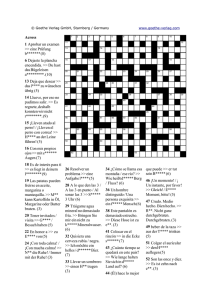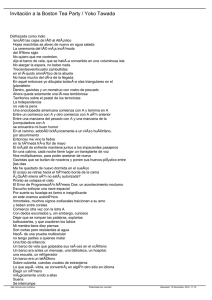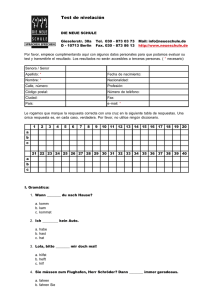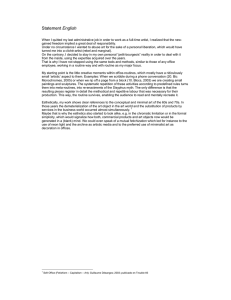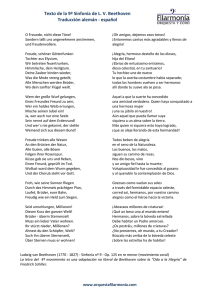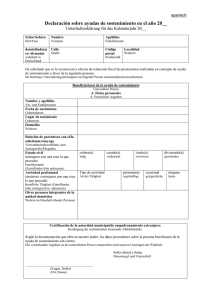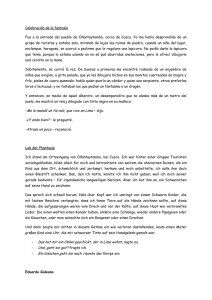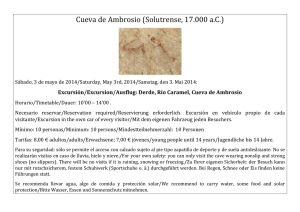fidel artikel
Anuncio
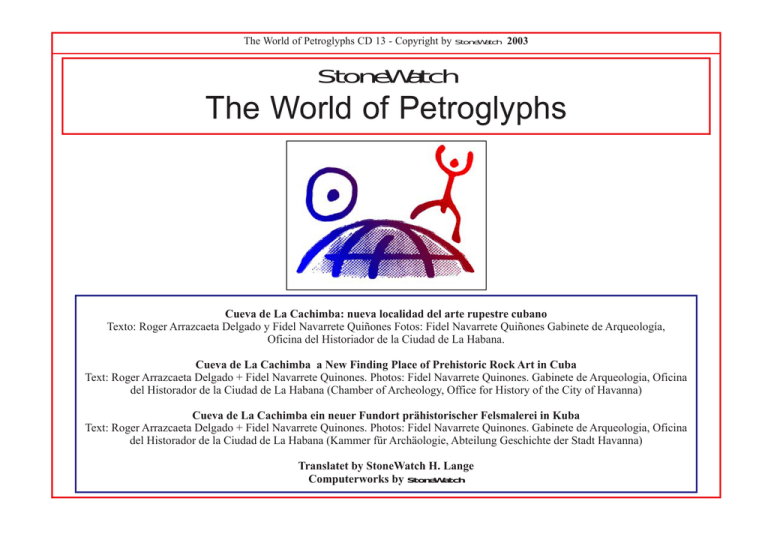
The World of Petroglyphs CD 13 - Copyright by StoneWatch 2003
StoneWatch
The World of Petroglyphs
Cueva de La Cachimba: nueva localidad del arte rupestre cubano
Texto: Roger Arrazcaeta Delgado y Fidel Navarrete Quiñones Fotos: Fidel Navarrete Quiñones Gabinete de Arqueología,
Oficina del Historiador de la Ciudad de La Habana.
Cueva de La Cachimba a New Finding Place of Prehistoric Rock Art in Cuba
Text: Roger Arrazcaeta Delgado + Fidel Navarrete Quinones. Photos: Fidel Navarrete Quinones. Gabinete de Arqueologia, Oficina
del Historador de la Ciudad de La Habana (Chamber of Archeology, Office for History of the City of Havanna)
Cueva de La Cachimba ein neuer Fundort prähistorischer Felsmalerei in Kuba
Text: Roger Arrazcaeta Delgado + Fidel Navarrete Quinones. Photos: Fidel Navarrete Quinones. Gabinete de Arqueologia, Oficina
del Historador de la Ciudad de La Habana (Kammer für Archäologie, Abteilung Geschichte der Stadt Havanna)
Translatet by StoneWatch H. Lange
Computerworks by StoneWatch
Seite / Page 1
The World of Petroglyphs CD 13 - Copyright by StoneWatch 2003
Cueva de La Cachimba:
nueva localidad
del arte rupestre
cubano.
Cueva de La Cachimba
a New Finding Place
of Prehistoric Rock Art
in Cuba
Cueva de La Cachimba
ein neuer Fundort
prähistorischer Felsmalerei
in Kuba
Texto: Roger Arrazcaeta Delgado y
Fidel Navarrete Quiñones
Fotos: Fidel Navarrete Quiñones
Gabinete de Arqueología,
Oficina del Historiador
de la Ciudad
de La Habana.
Text: Roger Arrazcaeta Delgado +
Fidel Navarrete Quinones.
Photos: Fidel Navarrete Quinones.
Gabinete de Arqueologia, Oficina del
Historador de la Ciudad de La Habana
(Chamber of Archeology, Office for
History of the City of Havanna)
Text: Roger Arrazcaeta Delgado +
Fidel Navarrete Quinones.
Photos: Fidel Navarrete Quinones.
Gabinete de Arqueologia, Oficina del
Historador de la Ciudad de La Habana
(Kammer für Archäologie, Abteilung
Geschichte der Stadt Havanna)
La cueva de La Cachimba constituye una de las
localidades de grabados rupestres más importante
de Cuba. Las razones para tal afirmación se fundan
en el gran número y diversidad de motivos representados, a su complejidad ideográfica y a su posible asignación a una cultura arqueológica de la etapa preagroalfarera antillana. Está ubicada en la
costa norte de la provincia de Matanzas, en el occidente del país, y se abre en el carso costero a dos
kilómetros del mar y a sesenta y tres metros de altitud, en una zona de terrazas emergidas crispadas
por espeluncas con yacimientos prehistóricos de
nivel mesolítico.
The Cavern of La Cachimba is one of the most
important localities of prehistoric excavation in
Cuba. The reasons for such evaluation are given in
a very large number and variety of motives, in the
high complexity of depictions and their possible
reference to a prehistoric culture of curvilinearly
decorated ceramics, generally known by the denomination of „band ceramics“, of the Caribbean
World. The cavern is situated on the north shore of
the province of Matanza in the western part of the
country, the access to the cavern lying in a karst
region at a distance of about 2 km from the coast,
on a 63 m high terrace traversed by a system of
caves where a rich deposit of prehistoric relicts
from the Mesolithic Era can be found.
Die Höhle von La Cachimba ist eine der bedeutendsten Fundorte von Felsgravuren in Kuba. Die
Gründe für eine solche Einschützung stützen sich
auf die große Anzahl und Vielfalt der dargestellten
Motive, auf die Komplexität der Darstellungen und
die mögliche Zuordnung zu einer prähistorischen
Kultur der Bandkeramikepoche in der Karibik. Die
Höhle liegt an der Nordküste der Provinz Matanzas
im Westen des Landes, der Zugang befindet sich in
einem Karstgebiet 2 km von der Küste entfernt in
63 m Höhe auf einer Terrasse, die mit Höhlen
durchzogen ist, in denen prähistorische Relikte aus
der Mittleren Steinzeit zu finden sind.
Esta cueva es notable entre una decena de sitios
aborígenes descubiertos en la zona arqueológica
denominada por nosotros como La Pluma, donde
muchos de los residuarios poseen una estrecha cercanía espacial y cultural. Las excavaciones del Gabinete de Arqueología en el salón vestibular de esta
gruta, desde el año 1996, confirman la presencia de
un asentamiento mesolítico de la etapa preagroalfa-
The Cavern of La Cachimba is the largest of a
group of 10 spots on the excavation territory which
is nowadays called La Pluma and with which
modern inhabitants still feel a strong nostalgic and
cultural relationship. The excavations performed
by the Ministry of Archeology in the entry hall of
Diese Höhle von Cachimba ist eine von etwa 10
Einzelstellen, die in dem Ausgrabungsgebiet liegen, das wir heute La Pluma nennen und zu der
viele Einwohner noch eine enge räumliche und
kulturelle Beziehung haben. Die Ausgrabungen des
Ministeriums für Archäologie in der Vorhalle dieser Grotte seit dem Jahre 1996 bestätigen das Vorhandensein einer mesolithischen Ansiedlung der
Seite / Page 2
The World of Petroglyphs CD 13 - Copyright by StoneWatch 2003
rera con una densidad estratigráfica de más de un
metro de espesor, abundancia de restos de alimentos debido a la recolección de moluscos marinos en
la zona intermareal y de moluscos terrestres; caza
de mamíferos, reptiles y aves; captura de crustáceos y pesca litoral. También se han recuperado por
las excavaciones una variedad de artefactos líticos
y de concha, y disímiles estructuras de fogones, suficientes elementos como para considerarlo un sitio
de habitación prolongado. Presenta condiciones
muy favorables para el asentamiento humano por
sus numerosos gours de agua potable de origen vadoso; buena iluminación en la entrada o salón vestibular, donde se encontraba en época prehistórica
el espacio de actividades comunitarias de trabajo y
culinario; y excelente ubicación para el acceso a
zonas de captación de alimentos diversificadas,
representadas por la costa y el bosque cársico.
Uno de los aspectos más relevante de este yacimiento prehistórico es su arte parietal, conformado
por algunas pictografías y sobre todo por petroglifos de gran complejidad y abstracción, que por su
cantidad, con más de 174 representaciones, lo convierten en el mural de grabados más grande del
país, con el excepcional legado ideológico de una
sociedad extinta del pasado. La doble funcionalidad de esta cueva, sitio de habitación y de arte rupestre, nos sugiere su uso especializado, posiblemente como Santuario y Campamento Base; un lugar sagrado donde podían haberse efectuado reuniones de clanes o concentraciones para ritos mágicos y animistas, o ceremonias de iniciación y representaciones de símbolos o ideogramas. De acuerdo al patrón de asentamiento de esta zona arqueológica, La Cachimba puede considerarse como
un sitio cabecera o principal, rodeado de una serie
de estaciones satélites con diferentes grados de
funcionalidad.
the grotto and started in the year 1996 confirm the
existence of a Mesolithic settlement of makers of
band ceramics, with a thickness of the stratum of
more than 1 m, with an abundance of food scraps
coming from earth and sea molluscs, from crustacean, but also from mammals, reptiles and birds all
of which were being gathered, hunted or trapped,
respectively. Furthermore, the ancient inhabitants
obviously were engaged in intensive inshore fishery. The excavations also revealed a series of stone
and shell devices of various construction and making and also many fire a place that suggests a
long-term period of residence. In fact, the dwellers
had found quite agreeable conditions of living in
this surroundings, as there is an ample supply of
drinking water, a good panorama visibility at the
entrance and the entry hall where very probably
common work and eating took place, and last but
not least a relatively easy and short-way access to
all resources for the provision of nourishment,
from the seaside to the depth of the wooded karst.
Bandkeramiker mit einer Schichtdicke von mehr
als 1 m, mit einer Menge von Speiseresten, die von
Erd- und Meeres-Molusken (Weichtieren), von
Krustentieren, aber auch von Säugetieren, Reptilien und Vögeln, die alle gesammelt, gefangen beziehungsweise erjagt wurden. Auch betrieben die
Bewohner offenbar eine intensive Küstenfischerei.
Die Ausgrabungen haben ferner eine Reihe von
Stein- und Muschelgebilden in verschiedenen
Strukturen und vielen Feuerstellen freigelegt, was
auf eine langfristige Wohnungsnahme schließen
lässt. Die Bedingungen für eine menschliche Ansiedlung sind aber auch recht günstig, denn es gibt
zahlreiche Ansammlungen trinkbaren Wassers, ferner gute Sichtverhältnisse im Eingangsbereich und
in der Vorhalle, wo sich das gemeinsame Arbeiten
und Essen abgespielt haben dürfte, und nicht zuletzt ein guter Zugang zu allen Gebieten der Nahrungsbeschaffung, von der Küste bis hin zu dem
karstigen Wald.
The extraordinary peculiarity of this prehistoric
residence, however, is its stonewall painting - pictography’s and petroglyphs of high complexity and
abstraction, impressive already by their large number: there are more than 174 individual depictions
on one of the most extensive canvasses, or panels,
in the whole country, an outstanding legacy from
an extinct society. There is at least a double fold
determination of the cavern, serving as a dwelling
and studio likewise - and perhaps, in addition to
that, as a shelter and harbour of refuge, an emergency deposit, and probably also as a holy place of
worshipping, a temple for an assembly of privileged persons and representatives of the tribes, and
for the performance of magic and animistic rites
and introductory ceremonies where a vocabulary of
symbols and hieroglyphs must be at hand for col-
Was aber dieser prähistorischen Niederlassung eine
besondere Wichtigkeit verleiht, sind die Wandmalereien - Piktographien und Petroglyphen von großer Komplexität und Abstraktion, die allein schon
wegen ihrer großen Zahl imponieren: Mit mehr als
174 Einzeldarstellungen haben wir es hier mit
einer der Ausgedehntesten Bildwände des Landes
zu tun, ein außergewöhnliches Vermächtnis einer
ausgelöschten Gesellschaft der Vergangenheit. Die
Doppelfunktion der Höhle als Wohnung und Atelier verweist uns auf eine spezielle Bedeutung eine heilige Stätte, ein Lager- oder Zufluchtsort
womöglich, oder eine Kultstätte für magische und
animistische Riten oder Einweisungszeremonien
mit einem Vorrat an Symbolen und Piktogrammen,
oder auch vornehmlich ein Versammlungsraum für
die Zusammenkünfte von Vertretern des Stammes.
Betrachtet man die Landkarte der prähistorischen
Seite / Page 3
The World of Petroglyphs CD 13 - Copyright by StoneWatch 2003
Los petroglifos y su ubicación
espacial
La primera cuestión con relación a este conjunto de
petroglifos es el espacio escogido y el soporte rocoso para su ejecución, ubicado en una galería del
segundo nivel de la espelunca en total oscuridad, y
aprovechando una caliza marga muy blanda y con
alto grado de porosidad o descalcificación. A este
lugar especial dentro de la cueva lo hemos llamado
Galería de los Petroglifos. En la misma sobresale
una zona por sus dimensiones y el gran número de
figuras. Este gran mural ocupa un área máxima de
unos 60 m2, con 157 figuras incisas sobre un techo
abovedado que se levanta de 1 a 2,5 m del nivel de
un suelo formado por un cono de derrumbes. A
unos 75 m de distancia se encuentran agrupados 5
dibujos hechos igualmente sobre el techo, en una
extensión de 1,5 m. La nitidez de los grabados en
ambos murales es buena, y no se observan deposiciones naturales ni alteraciones humanas recientes,
pero el estado de conservación del soporte rocoso
es precario y posee un inminente peligro de derrumbe.
Aparte se cuentan otros 8 trazos en una extensión
de 2 m sobre algunas rocas sueltas próximas al
gran mural. Su conservación respecto a la legibilidad de los dibujos es regular, ya que tienen una
fina capa de suciedad que limita su lectura visual.
Otras 4 imágenes sobre una pared y a una altura de
1,6 m del suelo conforman un pequeño mural
situado en una roca caliza de gran dureza. También
aparecen sobre las rocas de derrumbes de esta
galería dos zonas con petroglifos, que presumiblemente pudieran ser marcas topográficas para la orientación dentro de esta cueva.
lective understanding. Looking at the region's map
of prehistoric homes, it soon becomes evident that
La Cachimba was a central township surrounded
by a ring of satellites with various functions.
Niederlassungen, so kann innerhalb des Grabungsgebietes La Cachimba als ein Zentralplatz angesehen werden, umgeben von einem Ring von Satellitenstationen mit verschiedenen Funktionen.
The petroglyphs and their specific
occurrence
Die Petroglyphen und ihre speziellen
Vorkommen
The most important question about this collection
of petroglyphs refers to their location, the surfaces
used and the means of their realization. The depictions are located in a gallery on the 2nd floor of the
cavern, lying in absolute darkness, using an underground of a soft, very porose and deficient in lime,
i.e. a marly mineral bedrock. With respect to the
allocation within the cavern, we called the finding
place the 'Gallery of Petroglyphs'. It is estonishing
as to its dimensions and number of pictures. It consists of a huge panel of 157 individual engravings
on a surface of 60 m2 in a vault like camera, on a
level of 1 to 2.5 m above the soil. About 75 m apart
there is another group of 5 drawings, about 1.5 m
wide, on the ceiling. The distinctness of the engravings is good on either wall; we did not discover
any traces of natural sedimentation neither of recent man-made modifications, however, the stability of the rocky underground is hazardous due to an
undeniable high danger of collapse.
Die vordringliche Frage in Bezug auf diese
Ansammlung von Petroglyphen ist der ausgesuchte
Ort und der felsige Untergrund für die Ausführung,
angesiedelt in einer Galerie auf der zweiten Etage
der Höhle, in völliger Dunkelheit, unter Ausnutzung eines weichen und hochgradig porösen, kalkarmen Gesteins (Mergel). An diesem speziellen
Ort innerhalb der Höhle haben wir sie die „Galerie
der Petroglyphen“ genannt. Sie zeichnet sich durch
ihre Ausmaße und eine große Anzahl von Bildern
aus. Die(se) große Bildwand mit 157 gravierten
Abbildungen hat eine Fläche von etwa 60 m2 in
einem Gewölbe, das sich zwischen 1 und 2,5 m
über dem Boden erhebt. Etwa 75 m entfernt sind 5
Zeichnungen angeordnet, ebenfalls auf dem Dach,
in einer Breite von 1,5 m. Die Schärfe der Gravuren ist in beiden Wänden gut, und man beobachtet
keine natürlichen Ablagerungen, auch keine neueren Veränderungen von Menschenhand, aber der
Zustand und die Absicherung des felsigen Untergrundes ist prekär, denn es besteht eine immense
Einsturzgefahr.
There are another 8 drawings in a width of 2 m on
several of the rock projections near the large panel.
The condition of the drawings is satisfactory although they are covered by a thin layer of dirt
which restricts their legibility. Another 4 pictograms on a wall at 1.6 m from the bottom form a
small panel on a very hard limestone surface. Here
too, on a precipice of the gallery, 2 panels of petroglyphs appear before the visitor's eye which are
probably topographical landmarks for the purpose
Außerdem gibt es 8 weitere Zeichnungen in 2 m
Breite auf einigen Felsvorsprüngen nahe der großen Bildwand. Der Zustand der Zeichnungen ist
zufrieden stellend, obwohl sie mit einer feinen
Schmutzschicht bedeckt sind, die ihre Lesbarkeit
einschränkt. Weitere 4 Piktogramme auf einer
Wand in einer Höhe von 1,6 m über dem Boden
bilden ein kleines Wandbild auf sehr hartem Kalk-
Seite / Page 4
The World of Petroglyphs CD 13 - Copyright by StoneWatch 2003
La técnica empleada en la ejecución de estos
petroglifos es la de rayado o incisión sobre la roca,
algo muy singular para toda la región pictográfica
Habana-Matanzas. Quizás se trata de una técnica
genuina empleada por la comunidad humana de
este sitio, o bien el reconocimiento de las propiedades de esa roca para ser rayada con facilidad y
dejar visibles representaciones de sus manifestaciones culturales. Dentro de esta técnica destacan
dos tipos de trazados de líneas que constructivamente conllevaron el empleo de diferentes utensilios, uno de ellos es el de líneas simples que en
distintos dibujos tienen un ancho entre 1 y 9 mm y
una profundidad de 1 a 6 mm aproximadamente. El
otro tipo está compuesto por líneas dobles o paralelas, que debieron realizar empleando una herramienta de doble punta con una separación rígida que
oscilaba de 7 a 12 mm, y con un ancho y profundidad uniformes para cada línea de unos 4 y 3 mm
respectivamente. Finalmente un tercer tipo de
dibujo mixto une a estas otras dos tipologías referidas.
of orientation within the tunnel system of the
cavern.
Respecto a la técnica de ejecución es importante la
variedad de perfiles de los cortes hechos en la roca
para trazar los petroglifos, lo cual ayuda a determinar los tipos de artefactos usados para tal propósito y a reconstruir el modo en que fueron realizados.
Preliminarmente podemos distinguir perfiles en
forma de V y redondeados en forma de U; todos
con diferentes ángulos con relación a la pared. El
grado de estudio realizado hasta el presente no permite registrar individualmente cada uno de estos
dibujos y documentar un conjunto de características constructivas comunes en cada uno de los grupos de trazos, de manera tal que se pueda determinar el orden y relación entre las capas o estratos
simples de dibujos que fueron agregándose.
As to the realization technique of the depictions,
the multitude of profiles of the petroglyphic lines
gains importance as it makes our task easier to
determine the artists' tools and to retrace the technology of producing them. Prevailing are V-profiles and rounded U-profiles, all at varying angles
in relation to the wall surface. The level of knowledge of the studies undertaken so far does not
allow to register every drawing individually and to
set up a documention of common constructive characteristics between the different groups of drawings, in a sense that a certain style and relationship of the depictions in different layers might be
established.
The technique of realization of these petroglyphs
uses drawn-through lines or grooves, a peculiarity
in the entire pictology of the region of HabanaMatanzas. It seems to be the very own handicraft
of the aborigines practiced intensively by the ancient inhabitants of the region who wished to leave
their symbols and cultural manifestations on rock
surfaces which preferably should be easy to treat
by chiselling. The technique itself shows 2 types
of linear dipictions depending on 2 different tools the single-lining which is represent in many drawings and consists of grooves 1-3 mm broad and
1-6 mm deep, and the double or parallel lines that
must have been drawn by means of a two-tipped
iron tool which allows the making of two parallel
scratches simultaneously, at a constant interspace
of 7 or 12 mm and a depth of each line of 4 or 3
mm, respectively. Finally there is a 3rd method of
drawing lines, i.e. a mixture of the two aforesaid.
steinuntergrund. Auch erscheinen auf den jäh
abstürzenden Felsen dieser Galerie zwei Flächen
mit Petroglyphen, die vermutlich topographische
Merkzeichen zwecks Orientierung innerhalb dieser
Höhle sind.
Die bei der Ausführung dieser Petroglyphen angewandte Technik besteht aus gezogenen Linien oder
Einkerbungen in den Fels, etwas ganz Einzigartiges für das gesamte piktographische Gebiet Havanna-Matanzas. Vielleicht handelt es sich um eine
ureigene Technik der Eingeborenen, die von der
menschlichen Gemeinschaft dieses Gebietes angewandt wurde, vielleicht auch in Erkenntnis der
besonderen Eigenschaften des hier vorkommenden
Gesteins, das sich leicht ritzen lässt, um sichtbare
Zeichen ihrer kulturellen Manifestationen zu hinterlassen. Innerhalb dieser Technik heben sich zwei
Arten von gezogenen Linien besonders ab, die
konstruktiv die Verwendung verschiedener Werkzeuge erlauben. Eine davon ist die der einfachen
Linien, die in verschiedenen Zeichnungen zwischen 1 und 3 mm breit und etwa 1-6 mm tief sind.
Der andere Typ besteht aus doppelten oder parallelen Linien, die mittels eines eisernen Werkzeugs
mit doppelter Spitze und daher mit einem konstanten Abstand zwischen 7 und 12 mm gezogen wurden, bei einer gleichmäßigen Breite und Tiefe für
jede Linie von etwa 4 bzw. 3 mm. Schließlich
kommt noch ein dritter Typ hinzu, nämlich eine
Mischung der beiden beschriebenen Typologien.
Bezüglich der Ausführungstechnik sind die unterschiedlichen Schneidprofile der Linien wichtig, aus
denen die Petroglyphen bestehen, denn sie erleichtern uns die Aufgabe, die Werkzeuge der Künstler
und die Art und Weise, in der sie entstanden sind,
zu rekonstruieren. Als vorherrschend können wir
Profile in V-Form und abgerundete in U-Form
Seite / Page 5
The World of Petroglyphs CD 13 - Copyright by StoneWatch 2003
unterscheiden, alle mit verschiedenen Winkeln in
Relation zur Wand. Der Wissensstand der bis heute
durchgeführten Studien erlaubt es nicht, jede einzelne dieser Zeichnungen einzeln zu registrieren
und einen Zusammenhang gemeinsamer konstruktiver Charakteristika in jeder einzelnen der Zeichnungsgruppen zu dokumentieren, dergestalt, da·
man den Stil und die Beziehung zwischen den
Schichten und einfachen Lagen der hinzugefügten
Zeichnungen bestimmen könnte.
fig. 1
Otra técnica utilizada fue la de cavidades dactilares
o perforaciones circulares de 8 a 16 mm de diámetro y entre 3 y 10 mm de profundidad, probablemente ejecutadas con los dedos ejerciendo presión
sobre la roca blanda. El agrupamiento de algunas
de estas huellas sugiere el uso de varios dedos al
unísono. Se reportan unos 26 grupos o conglomerados de cavidades en la zona periférica del gran
mural (ver fig. N° 1), algunos están manchados
ligeramente de carbón, pero se desconoce hasta el
momento si ello obedece a un hecho fortuito o premeditado.
Another technique is to be presupposed concerning
the hollows or round depressions of 8-16 mm in
diameter and 3-10 mm in depth. They have been
made very probably by pressing one's bare fingers
against the soft stone. The arrangement of several
of these fingerprints suggests the application of
more than one finger at a time. 26 groups of hollows at the periphery of the large panel are recorded (see fig. 1), some of them slightly fouled with
charcoal and detectable only either by chance or
after intensive investigation.
Eine andere Technik ist für die Löcher oder runden
Höhlungen von 8-16 mm Durchmesser und einer
Tiefe zwischen 3 und 10 mm verantwortlich. Sie
entstanden wahrscheinlich dadurch, da· mit den
bloßen Fingern Druck auf den weichen Fels ausgeübt wurde. Die Anordnung einiger dieser Spuren
deutet auf den Gebrauch mehrerer Finger zur gleichen Zeit. Es sind 26 Gruppen von Höhlungen in
der Randzone der großen Wandbilder belegt (siehe
Abb. 1), einige sind leicht mit Kohle verschmutzt,
und man erkennt sie entweder nur zufällig oder
durch planmäßiges Vorgehen.
Seite / Page 6
The World of Petroglyphs CD 13 - Copyright by StoneWatch 2003
fig. 2
En la fig. N° 2 puede verse un ejemplo interesante
de esta tipología de representación petroglífica en
la que resalta una composición geométrica muy
precisa. Este petroglifo, de unos 16 cm de alto y 12
cm de ancho, está formado por tres pares de cavidades que inscriben los vértices de un triángulo y
se alinean en dirección de cada uno de estos vértices. Este caso puede aumentar o complejizar los
posibles usos y significados de estos orificios dactilares, que proyectan diferentes patrones espaciales, geométricos y numéricos.
Fig. 2 shows an interesting example of the said
typology of petroglyphic depictions with an extra
particuliarity of a very precise geometrical composition. This petroglyph is about 16 cm high and 12
cm broad and consists of altogether 3 pairs of hollows circumscribing the tops of a triangular and
describing the straight lines between them. This
figure obviously enlarges the meaning of the solely
numeric pattern of finger holes into a two- or
three-dimensional conception.
Abb. 2 zeigt ein interessantes Beispiel für diese
Typologie petroglyphischer Darstellung, wobei
eine präzise geometrische Komposition besonders
in die Augen springt. Diese Petroglyphe ist etwa 16
cm hoch und 12 cm breit und setzt sich zusammen
aus 3 Paar Mulden, die die Spitzen eines Dreiecks
und die Geraden zwischen ihnen beschreiben; sie
erweitert offenbar die Bedeutung der Zahlenmuster
von Fingerlöcher zu einer zwei- und dreidimensionalen Darstellung.
Seite / Page 7
The World of Petroglyphs CD 13 - Copyright by StoneWatch 2003
La amplia colección de representaciones en esta cueva muestra una compleja amalgama de figuras de estilo geométrico abstracto, mezcladas y superpuesta entre sí, y
concentradas densamente en el principal mural de petroglifos. En éste predominan
los grabados de líneas entrecruzadas o rediformes, líneas cortas y largas sin aparente unión, líneas paralelas simples o dobles, dibujos laberínticos o espirales, estrelliformes, cruciformes (ver figs. N° 3, 4 y 5), flechiformes y serpentiformes, saetas
dobles o triples, triángulos y otros elementos de marcado carácter lineal difíciles de
describir.
The ample accumulation of depictions in this cave comprises a complex mixture of
figures in an abstract geometric style, overlapping and super positioning each other,
and very dense on the main wall. Dominant engravings are crisscrossed and network lines, short and long strokes without clear interlocking, single and parallel
double lines, labyrinth-like confused sketches, spiral-, star- and cross-like (see fig.
3, 4, and 5), arrow- and snake-shaped drawings, double and triple arrows, triangulars and other elements of an impressive linear shape. All these figures are difficult
to describe.
fig. 3
Die große Ansammlung von Darstellungen in dieser Höhle zeigt ein komplexes
Gemisch von Figuren in geometrisch abstraktem Stil, gemischt und übereinandergestellt, dicht gedrängt in der Hauptwand mit Petroglyphen. Hier dominieren Gravuren aus durchkreuzten oder netzförmigen Linien, kurzen und langen Strichen
ohne offensichtliche Vereinigung, Einfachlinien oder parallelen Doppellinien, labyrinthartig verworrenen und spiral-, stern- oder kreuzförmigen (siehe Abb. 3, 4 und
5), pfeil- und schlangenförmigen Zeichnungen, doppelten und dreifachen Pfeilen,
Dreiecken und andere Elementen mit markantem Liniencharakter. Alle diese Figuren sind schwer zu beschreiben.
Seite / Page 8
The World of Petroglyphs CD 13 - Copyright by StoneWatch 2003
En unos pocos motivos creemos ver trazos de tipo esquemático que permiten en
apariencia una asociación con cosas identificables. Un ejemplo de ello lo apreciamos en la fig. N° 6, de 55 cm de longitud, donde aparece una imagen esquelética
de un pez, con su cabeza y ojo delineado, unidos a su espinazo. Superpuesta se
encuentran dos figuras rediformes. Una interpretación de lo que creemos observar
nos llevaría rápidamente a pensar en una escena de pesca, pero esto podría ser una
elucubración de nuestra mente más que una confirmación científica. No obstante,
resulta de mayor interés el hecho de que se trate de un petroglifo comparable por su
forma de representación a las pictografías esqueléticas antropomorfas encontradas
en dos sitios habaneros, uno a 45 km al suroeste, en la cueva García Robiou (Diago
Grande), y el otro a 62 km al oeste, en cueva de La Virgen.
With some of the motives we tend to recognize traces of schematic depictions allowing an association with real objects. There is the example (fig. 6) of a skeleton of
a fish having a length of 55 cm, with head and eye only indistinct but connected
with the fishbone. Above the fish, two network patterns. One of the interpretations
seems to give us the idea of fishing, but this conclusion goes more probably as a
result of imagination than of scientific confirmation. Nevertheless this finding is of
very great interest because it is a petroglyph which can be compared with two pictographies of human skeletons in two other caverns, one of which is Garcia Robiuo
at Diago Grande, 45 km southwest, the other - Cueva de la Virgen (The Cavern of
the Virgin) 62 km west of Havanna.
In einigen wenigen Motiven glauben wir Spuren schematischer Darstellungen zu
sehen, die eine Assoziation mit identifizierbaren Dingen erlauben. Ein Beispiel
dafür ist Abb. 6, die 55 cm lang ist und das Skelett eines Fisches darstellt; Kopf
und Auge sind nur angedeutet und mit der Wirbelsäule verbunden. Darüber befinden sich zwei netzartige Figuren. Eine Interpretation geht dahin, da· wir uns eine
Fischfangszene vorstellen sollen, aber sie bezieht ihre Wahrscheinlichkeit wohl
eher aus einer erweiterten Vorstellungskraft als aus wissenschaftlicher Bestätigung.
Dennoch ist dieser Fund von größtem Interesse, weil es sich um eine Petroglyphe
handelt, die in ihrer Darstellungsform mit den Humanskelettpiktographien in zwei
Höhlen vergleichbar ist, von der die eine (Garcia Robiou, Diago Grande) 45 km
südwestlich und die andere (Cueva de la Virgen - Höhle der Jungfrau) 62 km westlich von Havanna liegt.
fig. 4
Seite / Page 9
The World of Petroglyphs CD 13 - Copyright by StoneWatch 2003
Otro de los motivos con aspecto esquemático naturalista hace alusión a una figura
antropomorfa, fig. N° 7. Aquí se aprecia lo que parece ser una imagen humana esbozada verticalmente, con una longitud de 51 cm y un ancho de 26 cm, formada por una
cabeza y dos brazos que se envuelven en forma serpentiforme, un tronco algo rígido
une ambas partes a sus piernas. Muy cerca de este petroglifo aparece una imagen serpentiforme con un estilo, dimensión y factura parecido, que pudiera interpretarse
como una mítica escena de génesis de lo humano, que en la tradición espiritual de los
pueblos precolombinos y antillanos se ha vinculado con la serpiente.
Another motive with a schemato-naturalistic aspect is the anthropomorphical shape of
fig. 7. It represents a being horizontally sketched, appearing like a human one, 51 cm
long and 26 cm broad, with an assembly of a head and two arms, snakewise embracing each other, and a rather stiff rump combining these two parts with the legs. In the
close vicinity of this petroglyph a snake-like motive appears of the same style, size
and making which might be interpreted as a mythical scene about the creation of man,
as it corresponds with the spiritual tradition of the pre-Columbian peoples of the Antilles, in close relationship with the snake.
Ein anderes Motiv mit schematisch-naturalistischem Aspekt ist die anthropomorphe
Figur in Abb. 7. Hier ist ein Wesen horizontal skizziert, das ein Mensch zu sein
scheint, 51 cm lang und 26 cm breit, zusammengesetzt aus einem Kopf und zwei Armen, die sich schlangenförmig umschlingen; ein ziemlich steifer Rumpf vereinigt
beide Teile mit den Beinen. Ganz in der Nähe dieser Petroglyphe erscheint ein schlangenförmiges Motiv im selben Stil und in gleicher Größe und Herstellungsart, das man
als eine mythische Szene von der Erschaffung des Menschen interpretieren könnte, die
in der geistigen Tradition der präkolumbianischen Antillenvölker in enger Verbindung
mit der Schlange steht.
fig. 5
Seite / Page 10
The World of Petroglyphs CD 13 - Copyright by StoneWatch 2003
fig. 6
fig. 7
Otro de los aspectos principales de este gran mural
de petroglifos son las complejas superposiciones
de representaciones que se mezclan en un tapiz
aparentemente caótico de amplia perspectiva temporal, ver fig. N° 8.
Furthermore, there is the aforementioned feature of
complex overlapping of depictions on the large
petroglyphic wall, interwoven into a huge tapestry
of a long-range temporal perspective, see fig. 8.
Ein anderer wesentlicher Aspekt dieser großen
Petroglyphenwand ist die komplexe Überdeckung
von Darstellungen, die sich zu einem chaotischen
Teppich großer zeitlicher Perspektiven verweben,
siehe Abb. 8.
Seite / Page 11
The World of Petroglyphs CD 13 - Copyright by StoneWatch 2003
This panel not only invites the inspectors to study the
evolution of artistry of the authors, but also witnesses
their persistency and sedentariness in the place over a
period of time that can correspond with the estimated
data of two carbon isotope test results. The C14
method applied on local material, as a matter of fact,
confirmed the existence of two stratographical units
which can be ascertained in the entrance area and give
evidence of an occupancy of the cavern from 210 B.C.
up to 76 A.D.
The charcoal pollution partly present on almost every
slope and wall of the cavern shows a distinct coherence with the petroglyphs only in one case which certainly must be treated as an extra special of engravings.
Man erkennt hier nicht nur die künstlerische Evolution der Autoren, sondern auch ihre Sesshaftigkeit an
diesem Ort während eines Zeitraumes, der übereinstimmen könnte mit den geschätzten Daten der beiden
C14-Bestimmungen. Die hier angewandte C14Methode verweist nämlich auf zwei stratographische
Einheiten, die sich im Eingangsbereich nachweisen
lassen und Aufschluss geben über eine Belegungszeit
der Höhle von 210 v.Chr. bis 76 n.Chr.
fig. 8
Ello sugiere no sólo la evolución pictórica de los autores de estos murales, sino igualmente su permanencia
en este sitio durante un lapso de tiempo que pudiese estar acorde con los estimados hechos por los dos fechados de carbono 14 que se realizaron en dos unidades estratigráficas del área vestibular, y que reportan un
período de ocupación en esta espelunca desde el 210 a.n.e. al 76 d.n.e.
Resalta como un tipo diferente de representación rupestre las trazas y manchas de carbón que se encuentran
intermitentemente en casi todas las paredes y rocas de esta caverna, y que sólo en un caso se relacionan espacialmente con los petroglifos.
Die Kohleverschmutzung, die sich immer wieder auf
fast allen Wänden und Felsen dieser Höhle befinden,
gehen nur in einem Falle mit den Petroglyphen eine
enge Verbindung; diesen Fall muss man wohl als eine
besondere Art von Gravierung auffassen.
Seite / Page 12
The World of Petroglyphs CD 13 - Copyright by StoneWatch 2003
Pudiera pensarse que se trata de huellas de carbón
producidas al ser limpiados los desperdicios de la
combustión de las teas o antorchas que utilizaban
para alumbrarse los antiguos grupos humanos que
incursionaron en las profundidades de sus galerías.
O pudieran ser marcas topográficas que iban quedando o sirviendo para la orientación de sucesivas
exploraciones dentro de esta gruta.
Respecto al arte encontrado en otros residuarios
preagroalfareros existen varios casos que ameritan
ser mencionados por su relación con el sitio aquí
reportado. Uno de ellos es la Cueva de La Pluma, a
solo 200 m, donde se encuentra un arte con un estilo similar, incluso, motivos reiterados, aunque la
técnica de ejecución es diferente, pues se trata de
pictografías hechas en color rojo o negro. Otro
ejemplo es la Cueva de Mesa, a unos 235 km al
oeste, en la provincia de Pinar del Río, con representaciones de gran similitud en estilos y técnicas,
aunque en este sitio se realizó el rayado sobre una
superficie arcillosa que cubre la pared de esta
cueva. También un mural con el que se pudiera
establecer una relación estilística y técnica está en
la caverna conocida como Cinco Cuevas, a 45 km
al oeste, en la provincia de La Habana, que posee
una pictografía rayada de carácter geométrico. Asimismo, hay pictografías negras de igual carácter en
el complejo de cuevas de Cayo Caguanes, a 250
km al este en el archipiélago Sabana-Camagüey.
Finalmente, la importante región pictográfica de
Punta del Este, en Isla de Pinos, con sus numerosos
círculos concéntricos en color ocre, mantiene una
unidad interna por su estilo geométrico-abstracto.
They might be topographical markings facilitating
the orientation while investigating the interior of
the grotto. But there is also a certain probability of
being involuntary dust re-mainders from burning
torches. Those torches must have been used for
illumination by the people intruding more deeply
into the cavern.
Es können topographische Markierungen sein, die
bei der Erforschung der Grotte eine Orientierung
erleichtern. Man könnte aber auch meinen, es seien
unbeabsichtigte Kohlespuren aus Verbrennungsrückständen von Brand- oder Lichtfackeln. Solche
Fackeln haben damals den Menschen, die tiefer in
die Galerien eindrangen, als Lichtquellen gedient.
As far as the art trend found in other settlements of
makers of band ceramics is concerned, there are
many places that are worth being compared with
this site. The Cueva de la Pluma (Cavern of the
Feather) should certainly be mentioned in this
respect. It is situated only 200 m offside and with
repeating motives exemplifies a similar genre even
if the technique of realization is a bit different - the
pictographs of this site are in red and black paint.
Another example is the Cueva de Mesa (Cavern of
the Table) far away at a distance of 235 km in the
west, in the Province Pinar des Río, with very analogous depictions in style and technique although
in that place the engravings are done on a clay wall
surface. Then there is a comparable rock panel in a
grotto well-known under the name of Cinco Cuevas ('The Five Caves'), located about 45 km west
of it but still within the boundaries of the Province
of Havanna. This grotto bears a pictography with
lines of a geographical character. A black pictography of the same genre was found in the grotto
system of Cayo Caguanas, located 250 km eastward, on the archipelago of Sabana-Camagüey.
Finally, the important pictographic region of Punta
del Este on the Isla de Pinos reveals depictions of
numerous concentric circles in yellow ochre, manifesting an internal homogeneity due to its common
geometric-abstract style.
Was die Kunstrichtung betrifft, die an anderen Niederlassungen der Bandkeramiker vorgefunden
wurde, so gibt es viele Fülle, die in Verbindung mit
dem hier beschriebenen Ort zu erwähnen sind. Da
ist die nur 200 m entfernte Cueva de la Pluma
(Höhle der Feder) zu nennen, wo man ein ähnliches Genre vorfindet, sogar sich wiederholende
Motive, wenn auch in der Ausführungstechnik verschieden insofern, als es sich hier um Piktographien in roter oder schwarzer Farbe handelt. Ein anderes Beispiel ist die Cueva de Mesa (Höhle des
Tisches), etwa 235 km weiter westlich in der Provinz Pinar del Río gelegen, mit sehr ähnlichen Darstellungen bezüglich Stil und Technik, obwohl die
Gravuren an diesem Ort auf einer tonigen Oberfläche auf den Wänden dieser Höhle liegen. Eine weitere in Stil und Technik ähnliche Felswand befindet
sich in einer Grotte, die als Cinco Cuevas (Fünf
Höhlen) bekannt ist und sich 45 km westlich befindet, aber noch in der Provinz Havanna. Sie besitzt
eine Piktographie aus Linien mit geometrischem
Charakter. Ebenso gibt es schwarze Piktographien
desselben Charakters im Höhlenkomplex Cayo
Caguanas, 250 km östlich auf dem Archipel Sabana-Camagüey gelegen. Schließlich und endlich
bewahrt das bedeutende piktographische Gebiet
Punta del Este auf der Insel Isla de Pinos mit seinen Darstellungen zahlreicher ockerfarbener, konzentrischer Kreise eine innere Einheit aufgrund seines geometrisch-abstrakten Stils.
Seite / Page 13
The World of Petroglyphs CD 13 - Copyright by StoneWatch 2003
Bibliografía
Arrazcaeta, Roger y Robin García (1994): Guara: una región pictográfica
de Cuba. En: Revista de Arqueología. Año 15. No. 160. Agosto 1994.
González Morales, M. R.(1983): Grabados Lineales Exteriores de la
Cuevona (Ribadesella, Asturias). En Ars Praehistorica t. II (Separata), pp.
185-190.
Gutiérrez González, J. A. y José L. Avelló Alvarez (1986): Las Pinturas
Rupestres Esquemáticas de Sesamo, Vega de la Espinareda (León). Centro de Investigación y Museos de Altamira. Monografías No.12. Ministerio de Cultura. Dirección General de Bellas Artes, y Archivos.
Martínez C., Diego (1992): Guía de documentación de Arte Rupestre en
Colombia. GIPRI. Alcaldía Cívica de El Colegio. Editorial Cultura de los
Pueblos Pintores. Santa Fé de Bogotá, D.C.
Núñez Jiménez, Antonio (1975): Cuba: Dibujos Rupestres. Editorial de
Ciencias Sociales. Industria Gráfica S.A. La Habana-Lima, Perú.
(1984): El Arte Rupestre Cubano y su comparación con el de otras áreas
de América. Proyecto Regional de Patrimonio Cultural y Desarrollo. Primer Simposium Mundial de Arte Rupestre, Cuba.
(1985): Arte Rupestre de Cuba. Editoriale Jaca Book Spa, Italia.
Piñón Varela, Fernando (1982): Las Pinturas Rupestres de Albarracín
(Teruel). Centro de Investigaciones y Museo de Altamira. Monografías
No. 6. Ministerio de Cultura. Dirección General de Bellas Artes, Archivos y Bibliotecas, Santander.
Stölting, Siegfried (2001): From picture analysing to picture interpretation. The interpretation of scandinavian rock art. En: StoneWatch-magazin. Annual publication from StoneWatch. Society for coverage of prehistoric and ancient rockpaintings, pp. 22-24.
Swartz, B. K. and Thomas S. Hurlbutt (1994): Space, place and territory
in rock art interpretation. An integration of concepts of space and their
application to an usual petrogliph locality in the Great Basin, U.S.A. En:
Rock Art Research. Volume 11, number 1, May 1994, pp. 13-22.
Valencia, Vicente y Tomás Oropeza: Grabados Rupestres de Canarias.
Gobierno de Canarias. Viceconsejería de Cultura y Deportes. Dirección
General de Patrimonio Histórico. Segunda Edición, 1995.
Seite / Page 14
The World of Petroglyphs CD 13 - Copyright by StoneWatch 2003
Imprenta / Imprime / Impressum
StoneWatch
- Gesellschaft zur Erfassung vor- und frühzeitlicher Felsbilderist eine in Deutschland als gemeinnützig anerkannte wissenschaftlicheGesellschaft.
StoneWatch
-Society for coverage of prehistoric and ancient rockpaintingsis a German registered scientic nonprofit organisation.
StoneWatch
Gartenstrasse 2a
D- 55442 Warmsroth
Germany
Managing director: Josef Otto
Scientific director: Prof. Dr. Paolo Bonnevici
Tel. 0049 6724 93 94 44
Fax 0049 6724 95 62 1
e mail: [email protected]
www.stonewatch.de
CD Production: StoneWatch
